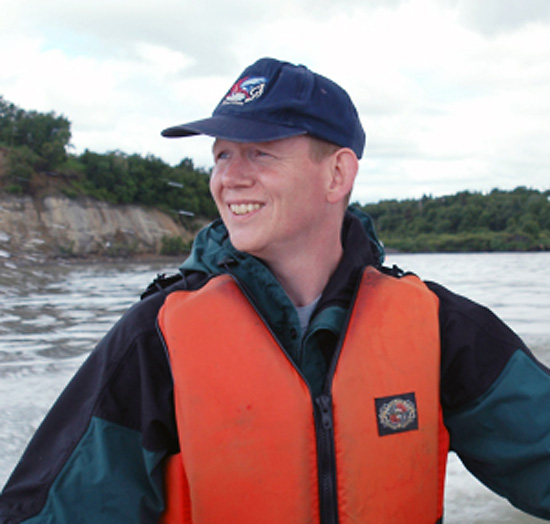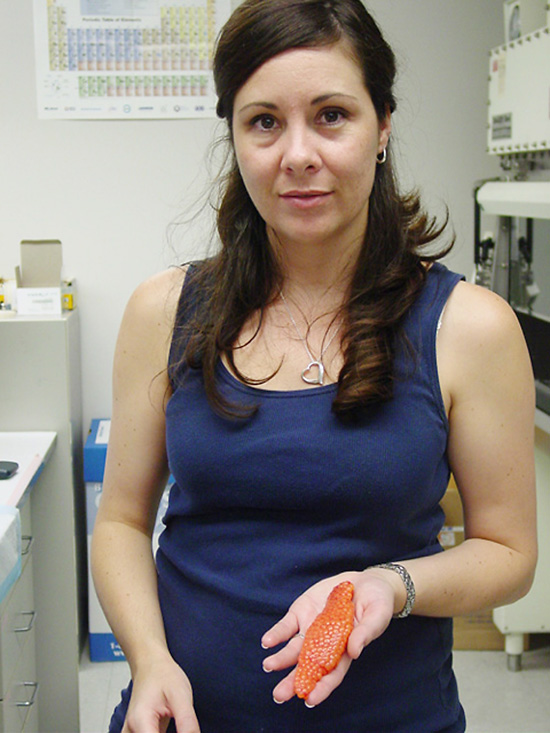Autumn 2013–
Winter 2014
Alumni Feature
Milo Adkison
PhD, UW, Aquatic and Fishery Sciences, 1994
Application of mathematical modeling to problems in salmon biology and management (Ray Hilborn and Tom Quinn, Faculty Advisers)
Adkison website

Photo courtesy of Milo Adkison.
Milo Adkison is a native Alaskan from Bristol Bay. He seems to have been destined for a career involving fish and fisheries. His grandfather was the winter watchman and a scow captain for a local cannery, and his father and uncles were commercial salmon fishermen. Milo spent some seven years crewing on a Bristol Bay driftnet vessel. Ultimately, his career path took him into academia, where he still focuses on fish and fisheries.
Milo earned an MS in Biology from Montana State University (1990), where he became interested in quantitative methods and statistics. For his thesis, he evaluated the statistical power of studies demonstrating smelter-derived acid rain in Colorado.
Milo then enrolled in the SAFS PhD program, with Ray Hilborn as his adviser. About a year into the program, Tom Quinn invited Milo to get involved in field studies at the Fisheries Research Institute camp at Iliamna, Alaska, and he became Milo’s co-advisor.
For his PhD research, Milo continued his quantitative focus, developing a mathematical model to show the limits on the ability of salmon populations to adapt to their local environment. He described the model as “useful for determining when we might expect populations to have important local adaptations and be vulnerable to genetic pollution from planted fish or hatchery strays.”
At Iliamna lake, Milo also studied sockeye salmon spawning: “We looked at the tradeoffs between selecting a great nest site and the higher degree of territorial defense required in these areas.” He quipped, “We finally published an article on this in the Environmental Biology of Fishes last year, much to the relief of Dr. Quinn!”
Milo reflected on his SAFS education: “When I finished my master’s degree, I thought I had a handle on fish and wildlife science. At SAFS, everyone was doing something I’d never seen before; it was exciting and useful. I learned humility and the value of seeking out people working from different paradigms. I also tried to adopt the openness and collegiality of the SAFS faculty and students—they shared their ideas and were genuinely invested in other people’s success.” He added that the reputation of SAFS opened a lot of doors for him and his peers, who have prominent positions with universities, management agencies, and other public and private entities world-wide. He added, “This peer network is very helpful.”
Milo credits the financial support from two SAFS endowments—the H. Mason Keeler and Roy Jensen fellowships—for helping him finish his dissertation work after his research assistantship expired. He also credits his teaching assistantship for Ellen Pikitch: “She allowed me significant opportunities to teach, which really gave me a head start when I started my faculty position.”
After SAFS, Milo spent several years as a postdoc in Canada, working with Randall Peterman at Simon Fraser University and for the federal government in Anchorage. He joined the University of Alaska, Fairbanks faculty (School of Fisheries & Ocean Sciences) in 1997.
Milo talked about his career choice: “In graduate school, I realized that I liked academics, and that I wanted to contribute to Alaskan fisheries. Fortunately, a University of Alaska faculty position in my specialty became available soon after I graduated.” At UAF, Milo has focused on Alaska’s salmon fisheries from varied perspectives, including management and biology, continuing to apply quantitative methodologies.
When asked about highlights in his academic career, Milo said, “One of my biggest thrills is seeing how many of the scientists and managers at the Alaska Department of Fish & Game and NOAA were students I taught or advised as a member of their graduate committees.” One particular graduate student, Kalei Shotwell, was especially memorable: “She looked at reconstructing historical salmon abundances for stocks of Yukon River chum, which were poorly monitored and had quite varied sources and quality of data. Her work has been adopted for many other stocks.”
Milo offered advice to students: “If you don’t love teaching and advising, then academia is not for you. If you love the science, you can do good research elsewhere, and maybe even have more time to do it than in academia.”
Balancing work and “life” is a big issue for Milo: “Because of my family I try not to work many evening or weekend hours, but sometimes there’s just too much to do. He observed that priorities for young versus senior faculty can differ: “Young faculty need to focus on what’s important and not put too much energy into trivia, whereas senior faculty have an important role in mentoring and protecting junior faculty so that they can succeed.”
Kristy Forsgren
PhD, UW, Aquatic and Fishery Sciences, 2010
Regulation of Development of Primary and Early Secondary Ovarian Follicles of Coho Salmon (Oncorhynchus kisutch) by Sex Steroids (Graham Young, faculty adviser)
Forsgren website

Photo courtesy of Kristy Forsgren.
Kristy Forsgren is a first-generation college student, who knew she wanted to become a professor as soon as she started college. Just a couple of years after earning her PhD in 2010, she joined the faculty at California State University, Fullerton.
Born and raised in Utah, Kristy first encountered the marine environment when she was 18, and fell in love with it. She pursued her passion, majoring in Marine Biology, followed by an MS degree in Biology, both at California State University, Long Beach.
At CSU Long Beach, Kristy became interested in fishes and fish reproduction, which led her to SAFS. Her PhD adviser was Graham Young—“a truly supportive and very knowledgeable professor”—with whom she conducted basic research on the roles of sex steroids in early ovarian development in coho salmon. She expanded: “Little is known about early ovarian development in fishes and this research provided important information on sex steroid regulation of the ovary in prepubescent fish.” Kristy’s research was largely lab-based, and included dissecting coho ovaries—from fish reared at the UW and the Northwest Fisheries Science Center hatcheries—and histologically processing them to examine the tissues under a light microscope.
During her PhD studies, Kristy was also a teaching assistant for Graham’s Aquatic Animal Physiology course: “I helped develop the laboratory portion of the course and guest lectured on animal reproduction.” Through a National Science Foundation East Asia Pacific Summer Institute award, Kristy spent a summer in Japan at the Funakoshi Marine Station, working with two top fish reproductive endocrinologists.
After earning her PhD, Kristy took a postdoctoral position at the University of California, Riverside, where she investigated the impact of endocrine-disrupting compounds (chemicals that “act” like naturally produced hormones) on the gonadal development of fishes. She elaborated: “These compounds are increasingly prevalent in our waterways and can potentially disrupt the hormone levels that regulate physiological processes in aquatic organisms.” With her goal of a faculty position, she taught courses on human physiology (Long Beach City College) and comparative animal physiology (California State University, Fullerton) .
When asked why Kristy was so interested in a faculty career, she responded, “I love learning, and teaching was a natural position for me. Also, several of my professors had a very positive influence on me and I wanted to be just like them. I hope I am able to inspire the next generation of marine scientists in the same manner.”
In July 2012, Kristy achieved her goal, becoming an assistant professor at CSU Fullerton, where she teaches animal physiology. She said: “I enjoy working with undergraduates and try to provide them with interesting and relevant information while challenging them to apply their scientific knowledge in class and in their research. The opportunity to work with both undergraduate and graduate students is what drew me to this position—it’s a perfect fit for me and my academic goals.”
Besides teaching, Kristy is continuing her research in fish physiology, focusing on basic two topics: “I’m interested in basic research that identifies the proteins involved in embryonic and gonadal development in fishes and exploring the roles of these proteins. This research will help us better understand the importance of proteins that accumulate in the ovarian follicle during early gonadal development.” She is also continuing her research on endocrine-disrupting compounds, looking at the effects of wastewater effluent and urban runoff on gonadal development and on the reproductive health of aquatic organisms.
Kristy reflected on her SAFS experience: “I received an excellent education. Interacting with great faculty and researchers at SAFS and NOAA Northwest Fisheries Science Center was invaluable. Also, a SAFS degree has had its advantages, as most people in the marine sciences are familiar with the School.”
Like so many of our alumni, Kristy benefited from the generosity of our donors. Support from the Walter Yonker Memorial Scholarship enabled her to purchase necessary supplies to conduct her PhD research.
As a young faculty member, Kristy seeks to balance her job and private life. She said, “It’s difficult to find time outside of work, but it’s a priority. Being well rounded and having interests beyond science keep me balanced and make me a better scientist.” These challenges led Kristy to impart some advice to students thinking about an academic career: “Make sure a faculty career is something you truly want to do. It’s not a back-up career plan! Also, there are different types of faculty positions (research, teaching, both), so be sure to choose the one that’s right for you.”
Speaking of balancing work and personal time, Kristy recently became a parent: “My baby boy occupies my free time these days.” But she still tries to make time for favorite pursuits such as snorkeling and diving, visiting museums, and when possible, traveling—“I try to visit a new place every year – even if it’s a place near me.”
